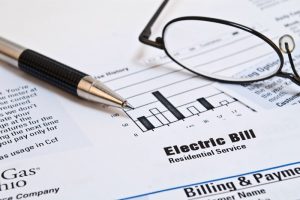 State regulators last December issued a series of orders that significantly reduced the record rate hikes ComEd and Ameren Illinois wanted, while also rejecting their plans to upgrade the power grid, ruling that they violated several provisions of the Climate and Equitable Jobs Act (CEJA).
State regulators last December issued a series of orders that significantly reduced the record rate hikes ComEd and Ameren Illinois wanted, while also rejecting their plans to upgrade the power grid, ruling that they violated several provisions of the Climate and Equitable Jobs Act (CEJA).
Below is our breakdown of ComEd and Ameren electric delivery rates and supply prices, as of Jan. 1. (Also, read our Q&A on the electric rulings.)
DELIVERY RATES
What are delivery rates?
Electric bills have two parts: delivery and supply. All of us pay delivery rates to cover the utilities’ costs of sending electricity over their wires to our homes–plus a profit for the companies. Those charges take up about a third to a half of the electric bill.
For a decade, Illinois set electric delivery rates for ComEd and Ameren according to the state’s 2011 “Energy Infrastructure and Modernization Act.” The law, which CUB opposed, used a formula to determine delivery rates, and it opened the door to about $1 billion in rate hikes and was at the heart of the ComEd corruption scandal.
But last year, the state launched a new system to set rates for the next four years. That process–created by the landmark state energy law, the Climate and Equitable Jobs Act–has given regulators more authority in rate cases. While this doesn’t mean the end of rate hikes, in their first rulings under the new system in December, the Illinois Commerce Commission (ICC) reduced the record increases sought by ComEd and Ameren by about 71 percent and also rejected their plans to upgrade the power grid, arguing that didn’t prove that they would be affordable and beneficial to consumers. (Read CUB’s Q&A on the ICC rulings.)
What else has caused by bill to go up?
Under Illinois utility law, if ComEd and Ameren don’t make the profit level that was set in the previous rate case, they are given extra money to make up the difference. (And if the utilities do better than planned, they have to reimburse customers.) This has been an advantage for the utilities. Most recently this “reconciliation” proceeding led to an extra $259 million being added to ComEd rates as of Jan. 1. As the Chicago Tribune editorialized: “One of the most obnoxious aspects of utility regulation in Illinois is that when rates are set for ComEd and downstate electricity utility Ameren Illinois, the companies are all but guaranteed a certain profit level.” CUB opposes this provision in Illinois law.
So what are we paying for delivery rates in 2024?
CUB dived into the tariffs and here’s what we found. These rates reflect the delivery rate hikes that Ameren and ComEd received on Jan. 1.
Ameren:
Meter Charge: $4.84/month (formerly $5.22/month)
Note: Covers meter-related services, such as installing, maintaining and testing meter equipment.
Monthly Customer Charge: $7.33/month (formerly $5.57/month) (Note: It was $6.69 from January through March 2024, but as of April it’s at $7.33 a month.)
Note: Helps cover the utility’s administrative costs of doing business, such as billing, postage and customer assistance.
EDT Cost Recovery Charge: 0.12531¢/kWh (formerly 0.13375¢/kWh)
Note: This charge recovers the Illinois Electricity Distribution Tax and is the same for all customer classes.
Distribution Delivery Charge Summer: 6.644¢/kWh (formerly 6.008¢/kWh).
Distribution Delivery Charge Non-Summer:
3.889¢/kWh for the first 800 kWh used (formerly 3.517¢/kWh)
2.063¢/kWh for usage over 800 kWh (formerly 1.867¢/kWh)
Note: The Distribution Delivery Charge covers the costs of maintaining equipment/wires and other costs not recovered through the customer charge.
ComEd:
Standard Metering Charge: $3.30/month (formerly $3.10/month)
Note: Covers meter-related services, such as installing, maintaining, and testing meter equipment.
IL Electricity Distribution Charge: 0.124 cents/kilowatt-hour (kWh) (formerly 0.132¢/kWh)
Note: This charge recovers the Illinois Electricity Distribution Tax and is the same for all customer classes.
Monthly Customer Charge
-
- Non-electric heat: $12.67/month for single-family homes (formerly $10.79/month), $9.64/month for multi-family (formerly $8.06/month)
- Electric heat: $14.44/month for single-family homes (formerly $12.23/month), $10.43/month for multi-family (formerly $8.70/month)
Note: Helps cover the utility’s administrative costs of doing business, such as billing, postage and customer assistance.
Distribution Facilities Charge
-
- Non-electric heat: 4.777¢/kWh for single-family (formerly 4.065¢/kWh), 3.659¢/kWh for multi-family (formerly 3.217¢/kWh)
- Electric heat: 2.307¢/kWh for single-family (formerly 1.888¢/kWh), 2.198¢/kWh for multi-family (formerly 1.827¢/kWh)
Note: The Distribution Facilities Charge covers the costs of maintaining equipment/wires, and other costs not recovered through the customer charge.
SUPPLY RATES
What are supply rates?
Supply rates cover the costs of the actual electricity. Unlike delivery charges, the utilities are not allowed to profit off the supply rate. They must pass onto customers what they pay for the electricity with no markup. Supply takes up about a half to two-thirds of your electric bill.
Note: You can opt to pay an alternative supplier for these rates–but most likely your best bet is to stay with your utility for supply. According to the state of Illinois, consumers have lost $1.6 billion to alternative electricity suppliers since 2015.
So what are the utilities charging for supply as of Jan. 1?
The utilities’ supply rates have gone down slightly for ComEd customers and up for Ameren customers in 2024. These are the rates through May:
ComEd Price to Compare:
6.848¢/kWh (down from October-December’s rate of 6.872¢/kWh)
Ameren Price to Compare:
8.683¢/kWh for 0-800 kWh of usage (up from October-December’s rate of 8.107¢/kWh)
7.670¢/kWh for usage above 800 kWh (up from December’s rate of 7.094¢/kWh)
For information on how to reduce your electric bill, check out CUB’s Energy Efficiency page and reach out for a utility bill clinic consultation at [email protected].

